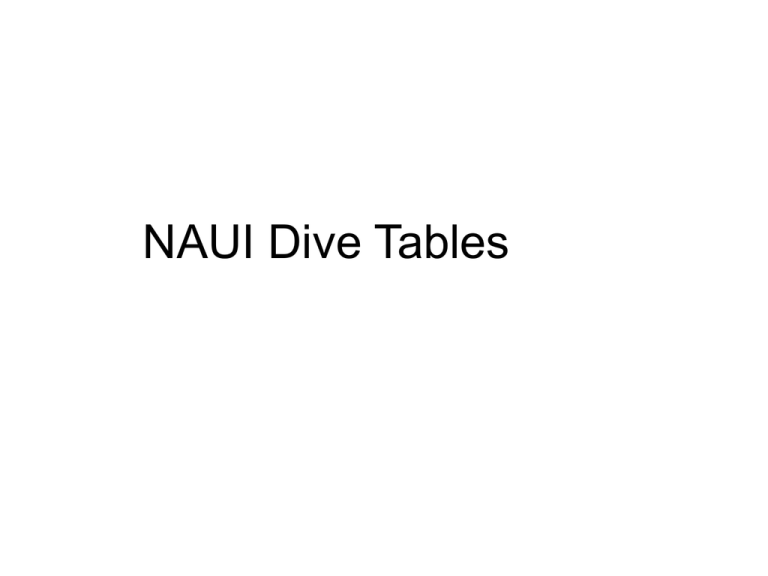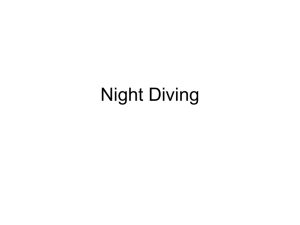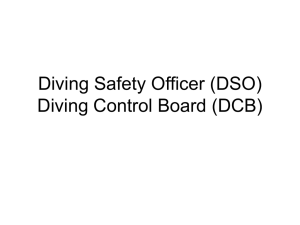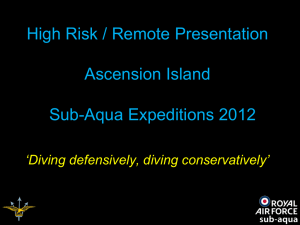NAUI Dive Tables: Dive Planning & Safety
advertisement

NAUI Dive Tables Objectives • Describe the function of the dive tables. • Define common dive tables terminology and concepts. • Explain the function and use of each individual table within the dive tables. • Plan repetitive dives not requiring stage decompression. • Calculate the minimum Surface Intervals for repetitive dives. • Determine contingency mandatory decompression stops. Purpose of the dive tables • Track the amount of Nitrogen you accumulate in your body during a series of dives. • Minimize the risk of Decompression sickness. • Set time and depth limits such that you can make a direct ascent to the surface with minimal increase in the risk of decompression sickness (DCS) Tables terminology and concepts • Dive Schedule/Dive Profile – Abbreviated statement of depth and time – 70/40=70 feet for 40 minutes • Actual Dive Time (ADT) – Surface to surface time, not including safety stop. • Depth – Deepest point of dive no matter how brief the time spent there. • Maximum Dive Time (MDT) – Maximum time you can spend on a dive to a given depth without requiring a mandatory decompression stop. • End-of-Dive Letter Group – Symbol representing amount of excess nitrogen in your body at the end of the dive. • Surface Interval (SIT) – Time on surface between dives. – During the SIT you are getting rid of some excess nitrogen (outgassing) and therefore your letter group, will change. • New Group – Letter group at the end of the SIT • Repetitive Dive (Rep Dive) – Any dive made within 24 hours of a preceding dive. • Residual Nitrogen Time (RNT) – Excess Nitrogen in your body after a dive – Represented by your new group at the end of the SIT • Adjusted Maximum Dive Time – The maximum dive time for a repetitive dive to a given depth. • Total Nitrogen Time (TNT) – Represents total nitrogen load in your body at the end of a dive – Determined by combining RNT +ADT = T NT • Safety Stop – Voluntary stop at the end of every dive – Facilitates outgassing of Nitrogen – Reduces the likelihood of bubble formation • Mandatory Decompression Stop (Deco stop) – Required stop at 15 feet whenever MDT or AMDT has been exceeded – Beyond the training of recreational diving Rules for Using the NAUI Tables • Rate of ascent – 1/2 foot per second or slower. • Depth – Use exact or next greatest number. • Time – Use exact or next greatest number • Dive sequence – Deep to shallow recommended • During the dive • For any rep. dive • SIT – – – – Minimum recommended Minimum recognized Keep activity to a minimum Drink water 1 hour 10 minutes • Depth limit recommendations – Sport Diving Maximum Depth 130” • Altitude Diving – Special training/tables required when diving at altitudes above 1000 feet. • Flying after diving – 1 recreational dive – Multiple recreational dives – Mandatory Decompression dive • Long, cold, strenuous dive – Use next greater TNT 12 hours 18 hours 24 hours Safety stops • Maintain mouth at 15' – Minimal activity throughout the stop. – Protocols: • Dives with a max depth of 40 feet – 3-minute stop at a depth of approximately15 feet. • Dives with a max depth deeper than 40 feet – initial 1-minute stop at a depth equal to ½ the Max depth, – followed by a 2-minute stop at a depth of 15 feet. • For example, on a dive to 100 feet of seawater (FSW), – make a 1-minute stop at a depth of approximately 50 feet, – followed by 2-minute stop at a depth of approximately 15 feet. Stage Decompression Diving • Dives that require a mandatory decompression stop. • Considered beyond the realm of sport diving – risk and special equipment considerations. – However you should have contingency information and be familiar with the minimal emergency procedures in case the maximum recreational dive time is exceeded. • Omitted Decompression – Missed mandatory decompression stop and no symptoms • Rest, drink fluids, and watch for signs of DCS. • Do not re-enter water for at least 24 hours. • If signs/symptoms of DCS are present treat for DCS Table 1 End-of-Dive Letter Group • Function – Provide MDT for initial dive in sequence – Provide end of dive letter group after any dive • Use – Find depth of dive in left hand column – Follow row for that depth to the right and find TNT – Follow column for TNT down to find end of dive letter group – Circled numbers indicate the maximum TNT you can accumulate for a dive to a given depth without the need for a mandatory decompression stop • Either for one dive or over a series of dives Table 2 Surface-Interval-Time (SIT) Table • Function – Track SIT • Use – Follow column for end of dive letter group designation down until you find the block of time that includes the time spent on the surface. – Follow that column to the right to your new group designation in table 3. Table 3 Repetitive Dive Timetable • Function – Provide new letter group designation – Provide Adjusted Maximum Dive Time (AMDT) – Provide Residual Nitrogen Time (RNT) • How to Use Table 3 – Find the row for your new group designation. – Follow this row to the left to the column for the planned depth of repetitive dive. – The box at the intersection of the column for planned depth and the row for new letter group designation provides: • RNT • AMDT Top number Bottom number – Use this information to plan your dive. Determining the End-of-Dive letter group designation for a rep dive • Based on – Actual depth of the dive – TNT (RNT + TNT) • Go to Table 1 End-of-Dive Letter Group – Find the actual depth of your dive in column 1 – Follow the row for that depth to the right until you find the TNT. – Follow this column down to find your end of dive letter group. Planning a minimum SIT • This process involves working backward from table 3. – Used when you must plan a minimum SIT between rep dives. • For example at the end of your dive you are an F diver and you want to go to 80 feet for 20 minutes. How long must you wait. • Look at table 3 Repetitive Dive Timetable – Find the column for 80 feet – Follow the column down until you find the AMDT closest to but still greater than 20 minutes. • Remember the AMDT is the bottom number in the box. – In our example it is the third box down which shows • RNT 13 • AMDT 22 • Follow that row to the right to find the highest letter designation that will allow 20 minutes at 80 feet. – In our example it is the letter C. • Continue working to the right until you find the intersection for the row C (the letter designation you must become), and the column for letter F at the bottom of table 1. (F is your current designation as given in the example.) • The box at the intersection of row C from table 3 and column F from table 1 indicates the SIT necessary to change from an F diver to a C diver. In this case it is 2:59 – 4:25, so we must wait a minimum of 2:59. • SIT of less than 10 minutes • Two dives separated by a SIT of less than 10 minutes are considered one dive on the tables. • For example: Dive 1 SIT Dive 2 = on the tables 60/40 0:08 50/30 = 60/70 Mandatory Decompression Stops • Found in table 1 – Boxes to the right of the circled numbers • Top number – Indicates ADT requiring Mandatory Deco stoop • Bottom number – # minutes that must be spent at 15 feet • Example – A diver has a dive schedule of 100 feet/23 minutes • The diver must spend 5 minutes at 15 feet • Note that any time from 22:01 – 25:00 requires this stop • A diver has a dive schedule of 100 feet for 35 minutes – The diver must spend 15 minutes at 15 feet. – Any time from 25:01 – 40:00 requires this stop. • The actual stage decompression tables for air diving are extensive. The information provided here is for contingency purposes only. • Stage decompression diving requires extensive training and equipment, and is beyond the realm of recreational diving. Before the Dive Prior to entering the water for any dive you must ask yourself, and answer, the following questions: • How much excess Nitrogen, if any, do I have left in my body from previous dives? – Residual Nitrogen Time or RNT • What will be the maximum depth of my dive? • What is my time limit for the planned depth of the dive? – First dive in a sequence Maximum dive time (MDT). – Repetitive dives Adjusted Maximum Dive Time (AMDT). Post Dive After the dive you must ask yourself, and answer, the following questions: • What was the maximum depth of my dive? • How long did I stay under water? – Actual Dive Time (ADT). • What is the total Nitrogen load in my body? – Total Nitrogen Time (TNT). • What is my end of dive letter group? Proper use of the dive tables includes: • Using the tables pre-dive to plan the dive. • Using the tables post dive to determine end-of-dive letter group. • Maximizes Bottom time or minimizes SIT • Minimizes the risk of DCS







